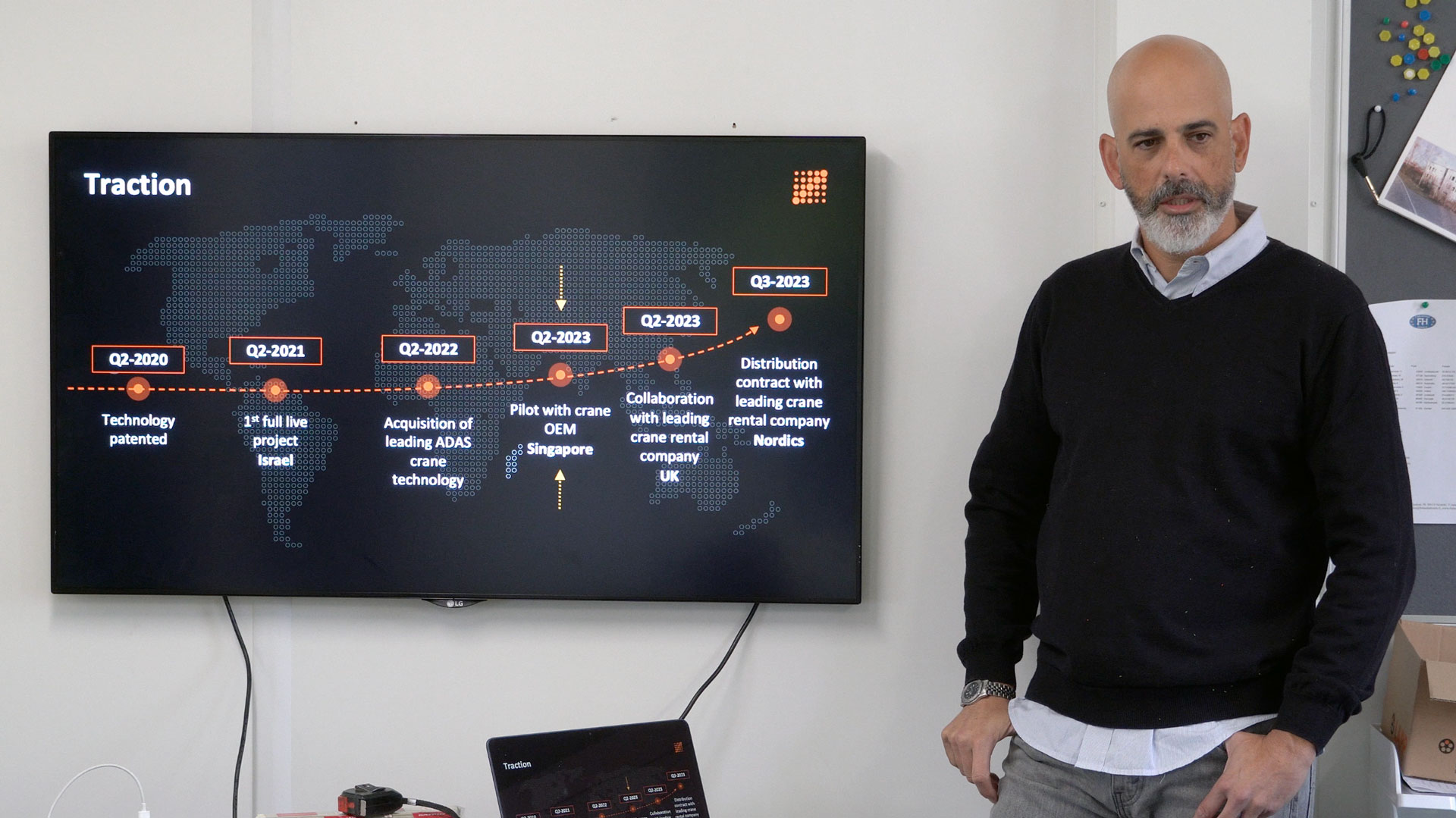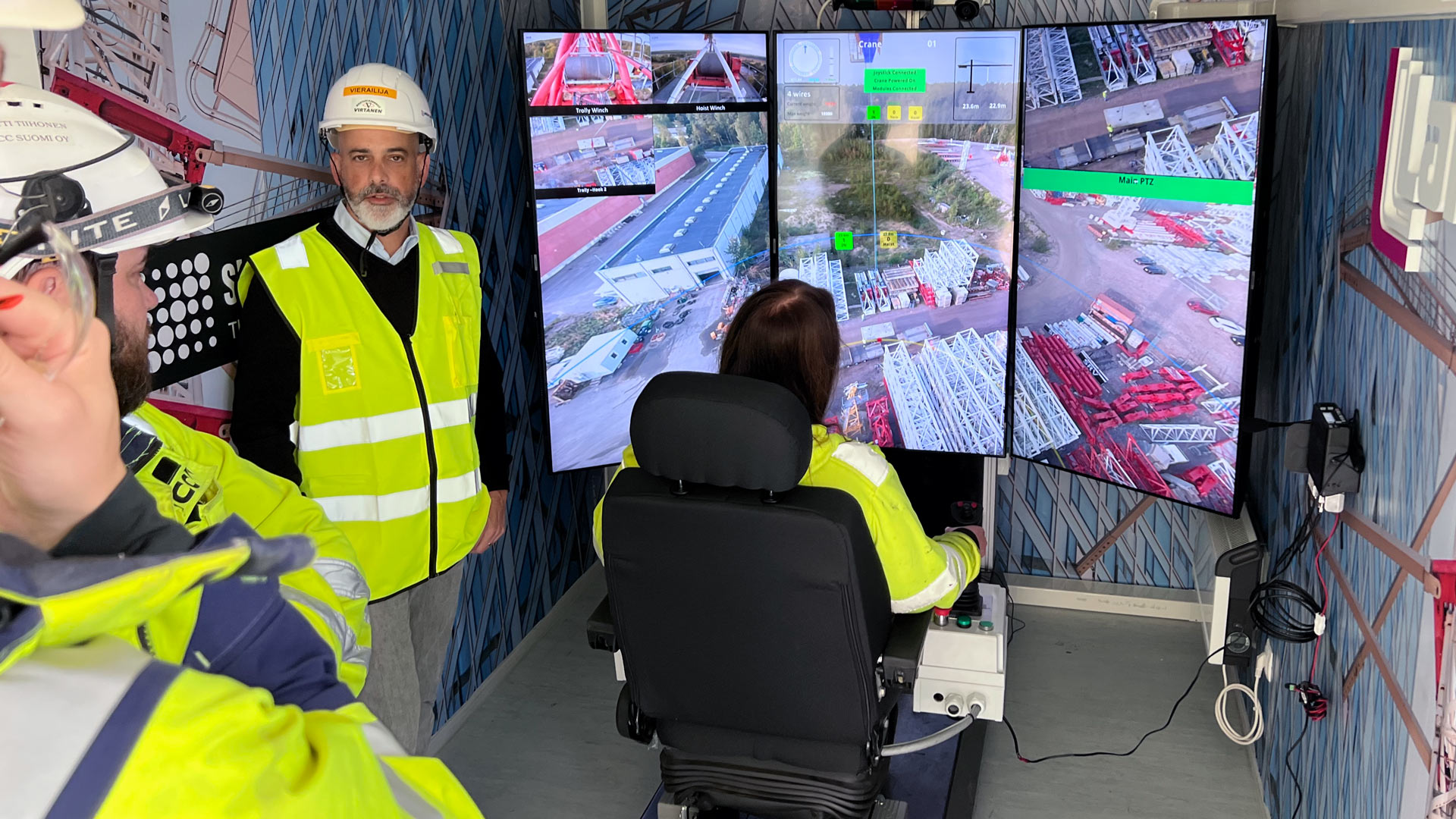The mobile tower crane was the brainchild of Hans Liebherr, a German inventor and entrepreneur who patented the design in 1949. The main technological advancement since then was the change to electric operation instead of hydraulic power in the 1970s. Now, we’re experiencing another change: teleoperation.
Last week, Zachi Flatto, the CEO and co-founder of Skyline Cockpit, invited me to Lambertsson’s crane depot in Vantaa. Zachi’s startup had a demo setup of their crane teleoperation solution on the site. It consisted of a ground control cabin with a steering unit and displays, cameras, and remote-control equipment installed on a tower crane. The control unit is connected to the crane with an optical cable.
In the control cabin, a crane operator steered one of the cranes on the site. She had three displays in front of her, providing a panoramic view from the crane, plus separate windows of the cameras showing trolly and hoist winches and the hook. There was also augmented reality info overlaying the main view.
The system also provides a remote management tool: a real-time dashboard showing data collected from each connected jobsite.
The thoughts of an operator

I interviewed the operator of the demo setup, Sonja. She’s a professional who has years of experience in steering a tower crane from the heights. Sonja said that testing the new way the first time gave the impression of playing a video game, but now the feeling is pretty much the same as being in the cockpit.
According to Sonja, one of the critical benefits of Skyline Cockpit is the ability to operate several cranes on the site from the same control unit. Being on the ground with a kitchenette and a restroom is an excellent bonus for the operator – no more climbing up and down during the workday.
Sonja thinks it is good to have muscle memory of the traditional way of operation before jumping in on the virtual version. However, that might change. She believes that remote operation opens career opportunities for people who disdain heights and even for those with disabilities.
Construction supervisors’ first impressions
I had a chance to chat with a team of visitors from NCC. One of them, Matti Tiihonen, said that some prejudice against teleoperation exists, but they got answers that alleviated their concerns. Up came also benefits to supervisors and the whole site, not just the crane operator.
Jyri Pilvi of NCC also saw potential in the concept and was looking forward to experiences from actual construction sites. He also envisioned a future where BIM models could supplement teleoperation. Pilvi noted that new technology might have some teething problems at the start. However, even the traditional operation has technical issues. For example, power blackouts are unfortunately quite common on construction sites.
One of the questions that came up during the demo was the performance of the system in harsh winter conditions. Zachi ensured that temperatures down to minus 20 Celsius were not a problem.
I understood from the discussion with the NCC team that teleoperation requires no additional operator certification. Zachi added that Skyline Cockpit already complies with several European and US safety standards.
In all, the feedback from these potential customers was very positive.
The background, present, and future of Skyline Cockpit
After the demo, Zachi gave a short presentation, first explaining the background of Skyline Cockpit. The startup is a spin-off of Skyline, Israel’s largest tower crane company, which owns approximately 250 tower cranes and operates hundreds more for major general contractors in the country.
Skyline Cockpit wants to tackle three significant challenges in traditional crane operation: safety, operator well-being, and efficiency.
The solution reduces the possibility of crane-related accidents, enforces safety regulations, and can reduce insurance rates. It helps the management by collecting and analyzing performance data. Integrating BIM applications enables automation, and the multi-crane operation with one control unit increases efficiency and reduces costs.
Soon, Skyline Cockpit will integrate LiDAR technology that provides real-time 3D awareness of the jobsite. The accurate point clouds will enable situation-aware automation of the crane operation, alert about safety hazards, and provide data on the operator’s efficiency.


Next steps in the Nordics
The demo continues at Lambertsson’s depot, but Zachi is eager to get hands-on with the first Finnish construction site. In addition to Israel, Skyline Cockpit has had pilots in Singapore, and they have started a collaboration with the leading crane rental company in the UK, and now in the Nordics.
My impression of Skyline Cockpit was very positive. Any company considering using the solution should make a business case study on the total costs, benefits, and risks of the new solution versus the existing one. I’m pretty sure that the outcome will be in favor of the new alternative.
View the original article and our Inspiration here


Leave a Reply